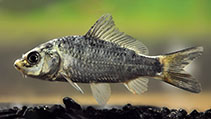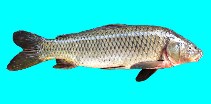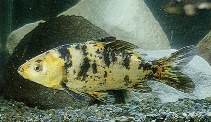United Kingdom country information
Common names:
Carp, Cerpyn, Wild common carp
Occurrence: introduced
Salinity: freshwater
Abundance: | Ref:
Importance: | Ref:
Aquaculture: commercial | Ref: FAO, 1997
Regulations: | Ref:
Uses: no uses
Comments: Invasive (Ref. 57517). Also Ref. 1739, 1998, 5204, 90052.
National Checklist:
Country Information: https://www.cia.gov/library/publications/resources/the-world-factbook/geos/uk.html
National Fisheries Authority:
Occurrences: Occurrences Point map
Main Ref: Davies, C., J. Shelley, P. Harding, I. McLean, R. Gardiner and G. Peirson (eds.), 2004
National Database:
Occurrence: introduced
Salinity: freshwater
Abundance: | Ref:
Importance: | Ref:
Aquaculture: commercial | Ref: FAO, 1997
Regulations: | Ref:
Uses: no uses
Comments: Invasive (Ref. 57517). Also Ref. 1739, 1998, 5204, 90052.
National Checklist:
Country Information: https://www.cia.gov/library/publications/resources/the-world-factbook/geos/uk.html
National Fisheries Authority:
Occurrences: Occurrences Point map
Main Ref: Davies, C., J. Shelley, P. Harding, I. McLean, R. Gardiner and G. Peirson (eds.), 2004
National Database:
Common names from other countries
分类 / Names 俗名 | 同种异名 | Catalog of Fishes(属, 种) | ITIS | CoL | WoRMS | Cloffa
Teleostei > Cypriniformes (Carps) > Cyprinidae (Minnows or carps) > Cyprininae
Etymology: Cyprinus: Latin, cyprinus = carp (Ref. 45335); carpio: carpio is the latinized form of carp (Ref. 1998). Cyprinus is the old world name for the carp (Ref. 10294).
More on author: Linnaeus.
Etymology: Cyprinus: Latin, cyprinus = carp (Ref. 45335); carpio: carpio is the latinized form of carp (Ref. 1998). Cyprinus is the old world name for the carp (Ref. 10294).
More on author: Linnaeus.
Environment: milieu / climate zone / depth range / distribution range 生态学
; 淡水; 半咸淡水 底中水层性; pH range: 6.5 - 9.0; dH range: 10 - 15; 河川洄游 (Ref. 51243); 深度上下限 0 - 29 m (Ref. 120823). 溫帶; 3°C - 35°C (Ref. 12741); 54°N - 34°N, 12°E - 74°E (Ref. 59043)
分布 国家 | FAO区域 | 生态系 | 标本纪录 | Point map | 简介 | Faunafri
Europe to Asia: Black, Caspian and Aral Sea basins. Introduced throughout the world. Wild stocks are only present naturally in rivers draining to the Black, Caspian and Aral Sea (Ref. 59043). A reophilic wild population in the Danube is assumed to be the origin of the European species; this population is now under threat (Ref. 13696).
西歐在歐亞大陸到中國各處, 與亞洲東南部,西伯利亞與印度。 第一個種之一被引入其他的國家中而且現在達到全球的分布。 證明的內陸的水產業與漁撈業貢獻非常重要。 在多瑙河的一個 reophilic 荒野族群被假定為歐洲種的起源; 這族群是現在處於威脅情況。 (參考文獻 13696) 引入後的一些國家報告不利的生態衝擊。
西歐在歐亞大陸到中國各處, 與亞洲東南部,西伯利亞與印度。 第一個種之一被引入其他的國家中而且現在達到全球的分布。 證明的內陸的水產業與漁撈業貢獻非常重要。 在多瑙河的一個 reophilic 荒野族群被假定為歐洲種的起源; 這族群是現在處於威脅情況。 (參考文獻 13696) 引入後的一些國家報告不利的生態衝擊。
Length at first maturity / 大小 / 重量 / 年龄
Maturity: Lm 34.8, range 25 - 36 cm
Max length : 120 cm TL 雄鱼/尚未辨别雌雄; (Ref. 27549); common length : 31.0 cm TL 雄鱼/尚未辨别雌雄; (Ref. 3561); 最大体重: 40.1 kg (Ref. 72380); 最大年龄: 38 年 (Ref. 72479)
Max length : 120 cm TL 雄鱼/尚未辨别雌雄; (Ref. 27549); common length : 31.0 cm TL 雄鱼/尚未辨别雌雄; (Ref. 3561); 最大体重: 40.1 kg (Ref. 72380); 最大年龄: 38 年 (Ref. 72479)
简单描述 检索表 | 型态特徵 | 形态测量图
背棘 (总数) : 3 - 4; 背的软条 (总数) : 17 - 23; 臀棘: 2 - 3; 臀鳍软条: 5 - 6; 脊椎骨: 36 - 37. Diagnosed from other cyprinid species in Europe by having the following characters: 2 pairs of barbels; dorsal fin with 15-20½ branched rays; caudal fin deeply emarginate (Ref. 59043). Pharyngeal teeth 1, 1, 3:3, 1,1, robust, molar-like with crown flattened or somewhat furrowed. Scales large and thick. `Wild carp ' is generally distinguished by its less stocky build with height of body 1:3.2-4.8 in standard length. Very variable in form, proportions, squamation, development of fins, and color. Caudal fin with 3 spines and 17-19 rays (Ref. 2196). Last simple anal ray bony and serrated posteriorly; 4 barbels; 17-20 branched dorsal rays; body grey to bronze (Ref. 43281). Also Ref. 3398, 3410.
咽齿 1,1,3:3,1,1, 结实的, 臼齿状的具有冠平的或略微犁了。 鳞片大而厚的。 荒野鲤鱼 ' 通常被藉着它的区别比较不矮胖在标准的长度中有身体 1:3.2-4.8 的高度建立。 形式,比例,鳞片的排列,鳍的发展与颜色变异很大。 尾鳍有 3根棘与 17-19个鳍条。 (参考文献 2196) 最后单一的臀鳍鳍条多骨的而且在后部地锯齿状的; 4个触须; 17-20个分枝的背鳍鳍条; 身体灰色的到青铜色的.(参考文献 43281) 也参考文献 3398,3410.
咽齿 1,1,3:3,1,1, 结实的, 臼齿状的具有冠平的或略微犁了。 鳞片大而厚的。 荒野鲤鱼 ' 通常被藉着它的区别比较不矮胖在标准的长度中有身体 1:3.2-4.8 的高度建立。 形式,比例,鳞片的排列,鳍的发展与颜色变异很大。 尾鳍有 3根棘与 17-19个鳍条。 (参考文献 2196) 最后单一的臀鳍鳍条多骨的而且在后部地锯齿状的; 4个触须; 17-20个分枝的背鳍鳍条; 身体灰色的到青铜色的.(参考文献 43281) 也参考文献 3398,3410.
Inhabits warm, deep, slow-flowing and still waters such as lowland rivers and large, well vegetated lakes (Ref. 59043). Hardy and tolerant of a wide variety of conditions but generally favor large water bodies with slow flowing or standing water and soft bottom sediments. Thrive in large turbid rivers (Ref. 1998). Most active at dusk and dawn. Both adults and juveniles feed on a variety of benthic organisms and plant material. Breeds along shores or in backwaters. Adults often undertake considerable spawning migration to suitable backwaters and flooded meadows. Larvae survive only in very warm water among shallow submerged vegetation (Ref. 59043). Occurs at depths of <30m (Ref. 120613) and found sucking in floating insects at the surface (Ref. 120823). River regulation and hybridization with domesticated stocks, East Asian congeners and their hybrids have caused continuous decline of wild populations (Ref. 59043). Utilized fresh and frozen (Ref. 9987). Aquarium keeping: in groups of 5 or more individuals; minimum aquarium size >200 cm; not recommended for home aquariums (Ref. 51539).
在一个 3-35个 ° C. 的温差出现 强韧与宽容的各式各样环境但是通常喜欢大的水体具有慢的流动或静止的水域与软质底部沉淀物。 普遍的鲤鱼繁荣较大时混浊的河。 他们是杂食性的, 主要捕食水生昆虫,甲壳动物,环节动物,软件动物,杂草与树种子,野生的米,水生植物与藻类; 主要地借着翻掘在沉淀物中.(参考文献 1998) 产卵于被产黏性卵在浅水植物中的春天与夏天中。 (参考文献 7248) 一条母鱼 47 公分长生产大约 300,000个卵。 (参考文献 6885) 幼鱼可能被被北方青旗鱼,大梭鱼與大嘴花鱸捕食。 成魚連根拔起而且破壞水下的水生植物因此可能是對鴨子與原生的魚族群有害.(參考文獻 1998) 生鮮使用與冷凍.(參考文獻 9987) 水族館保持: 形成 5個或更多個體的群體; 水族館最小體型 >200 公分; 不為家庭的水族箱魚推薦。 (參考文獻 51539)
在一个 3-35个 ° C. 的温差出现 强韧与宽容的各式各样环境但是通常喜欢大的水体具有慢的流动或静止的水域与软质底部沉淀物。 普遍的鲤鱼繁荣较大时混浊的河。 他们是杂食性的, 主要捕食水生昆虫,甲壳动物,环节动物,软件动物,杂草与树种子,野生的米,水生植物与藻类; 主要地借着翻掘在沉淀物中.(参考文献 1998) 产卵于被产黏性卵在浅水植物中的春天与夏天中。 (参考文献 7248) 一条母鱼 47 公分长生产大约 300,000个卵。 (参考文献 6885) 幼鱼可能被被北方青旗鱼,大梭鱼與大嘴花鱸捕食。 成魚連根拔起而且破壞水下的水生植物因此可能是對鴨子與原生的魚族群有害.(參考文獻 1998) 生鮮使用與冷凍.(參考文獻 9987) 水族館保持: 形成 5個或更多個體的群體; 水族館最小體型 >200 公分; 不為家庭的水族箱魚推薦。 (參考文獻 51539)
Life cycle and mating behavior 成熟度 | 繁殖 | 产卵场 | 卵 | 孕卵数 | 仔鱼
Spawn in marginal, shallow, weed-infested areas. A polytypic plastic species with a marked tendency to produce `varieties' and `races' in response to selective breeding and environmental influences. Carp is polygamous. A spawning female is usually followed by several males. Under tropical conditions carp breeds throughout the year. It is a seasonal spawner in temperate waters (Ref. 185). Females are known to lay more than a million eggs in a season; breeds at a temperature range of 15° C to 20°C; eggs hatch in 4 days (Ref. 6028). Obligatory plant spawners (Ref. 7471). "Adults often make considerable spawning migrations to suitable backwaters and flooded meadows. Individual females spawn with a few males in dense vegetation. The sticky eggs are attached to water plants or other submerged objects. Reproductive success is restricted to years when the water level starts rising in May and when high temperatures and flooding of terrestrial vegetation last for a long period during May and June" (Ref. 59043).西歐在歐亞大陸到中國各處, 與亞洲東南部,西伯利亞與印度。 第一個種之一被引入其他的國家中而且現在達到全球的分布。 證明的內陸的水產業與漁撈業貢獻非常重要。 在多瑙河的一個 reophilic 荒野族群被假定為歐洲種的起源; 這族群是現在處於威脅情況。 (參考文獻 13696) 引入後的一些國家報告不利的生態衝擊。
主要参考文献
Upload your references | 参考文献 | 合作者 | 合作者
Kottelat, M. and J. Freyhof, 2007. Handbook of European freshwater fishes. Publications Kottelat, Cornol and Freyhof, Berlin. 646 pp. (Ref. 59043)
对人类的威胁
潜能有害之物
人类利用
渔业: 高经济性; 养殖: 商业性; 游钓鱼种: 是的; 水族馆: 商业性
更多信息
Population dynamics
成长参数
Max. ages / sizes
Length-weight rel.
Length-length rel.
体长-频率
Mass conversion
入添量
丰度
成长参数
Max. ages / sizes
Length-weight rel.
Length-length rel.
体长-频率
Mass conversion
入添量
丰度
Physiology
Body composition
Nutrients
耗氧量
游泳类型
游泳速度
Visual pigments
Fish sound
Diseases & Parasites
Toxicity (LC50s)
Body composition
Nutrients
耗氧量
游泳类型
游泳速度
Visual pigments
Fish sound
Diseases & Parasites
Toxicity (LC50s)
工具
Bio-Quiz | E-book | 野外调查 | 检索表 | 长度- 频率 Wizard | 生活- 历史的工具 | 分布图 | Classification Tree
| Catch-MSY |
特别资料
下载 XML
网络资源
Alien/Invasive Species database | Aquatic Commons | BHL | Cloffa | BOLDSystems | Websites from users | 核实 FishWatcher | CISTI | Catalog of Fishes(属, 种) | DiscoverLife | DORIS | ECOTOX | Faunafri | Fishtrace | GenBank(基因组, 核苷酸) | GloBI | GOBASE | | Google Books | Google Scholar | Google | IGFA World Record | MitoFish | 国家资料库 | Otolith Atlas of Taiwan Fishes | 公众的水族馆 | PubMed | Reef Life Survey | Scirus | SeaLifeBase | 树状分类阶层 | Wikipedia(转至, 搜寻) | World Records Freshwater Fishing | Zoobank | 动物学的记录
Estimates based on models
Phylogenetic diversity index (Ref. 82804): PD50 = 0.5000 [Uniqueness, from 0.5 = low to 2.0 = high].
Bayesian length-weight: a=0.01778 (0.01629 - 0.01941), b=2.95 (2.92 - 2.98), in cm Total Length, based on LWR estimates for this species (Ref. 93245).
营养阶层 (Ref. 69278): 3.1 ±0.0 se; based on diet studies.
回复力 (Ref. 120179): 中等的, 族群倍增时间最少 1.4 - 4.4年 (K=0.10-0.30; tm=1-3; tmax=20; Fec=36,000-2,000,000).
Fishing Vulnerability (Ref. 59153): High vulnerability (60 of 100).






